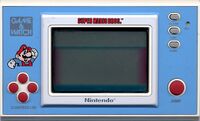Super Mario Bros. (Game & Watch): Difference between revisions
(Bowser) |
|||
| Line 17: | Line 17: | ||
==Plot== | ==Plot== | ||
[[Bowser | [[Bowser]] has kidnapped [[Princess Peach|Princess Toadstool]], and [[Mario]] is off to save her. The difference is that at the end of every level, Mario will find the Princess without having to fight a boss. | ||
==Gameplay== | ==Gameplay== | ||
| Line 27: | Line 27: | ||
* [[Mario]] | * [[Mario]] | ||
* [[Luigi]] | * [[Luigi]] | ||
*[[Bowser]] | |||
* [[Bullet Bill]] | * [[Bullet Bill]] | ||
* [[Lakitu]] | * [[Lakitu]] | ||
* [[Princess Peach|Princess Toadstool]] | * [[Princess Peach|Princess Toadstool]] | ||
* [[Mushroom Retainer]] | * [[Mushroom Retainer]] | ||
* | * | ||
==Levels== | ==Levels== | ||
| Line 41: | Line 42: | ||
* World No. 6 Beam | * World No. 6 Beam | ||
* World No. 7 Maze | * World No. 7 Maze | ||
* World No. 8 | * World No. 8 [[Bowser's Castle]] | ||
==Connections== | ==Connections== | ||
Revision as of 17:03, September 7, 2013
It has been requested that this article be rewritten and expanded to include more information.
Template:Infobox Super Mario Bros. is a Game & Watch version of Super Mario Bros. which appeared as part of the New Widescreen and Crystal Screen series, both of whom were predated by an extremely rare "special" Game & Watch shaped like Famicon mascot Diskun which was awarded to winners of the F-1 Grand Prix Tournament in Japan.[1][2]
These versions of Super Mario Bros. are all essentially the same except for hardware (the Crystal Screen had a transparent screen, while the other two versions were more basic Game & Watch systems). The overall plot is the same as the console Super Mario Bros., but the game is shorter and simpler.
Plot
Bowser has kidnapped Princess Toadstool, and Mario is off to save her. The difference is that at the end of every level, Mario will find the Princess without having to fight a boss.
Gameplay
Mario must go through eight auto-scrolling levels without falling and losing a life. When the levels are cleared, Mario must repeat them in the next loop. The second loops and onward have enemies. Further, Lakitus throw hammers as opposed to Spinies. There are a total of nine loops of increasing difficulty. There are two types of levels; scroll screen levels and timer screen levels. In the scroll screen levels, Mario must travel a given distance displayed on the screen. In the timer screen levels, Mario has to go through the world within a given time. [3]
Characters
Levels
- World No. 1 Canyon
- World No. 2 Gym
- World No. 3 Burning Room
- World No. 4 Channel
- World No. 5 Hop
- World No. 6 Beam
- World No. 7 Maze
- World No. 8 Bowser's Castle
Connections
- Super Mario Bros. - shared title and storyline.
References
- ^ The Handheld Games Museum: the "Special" Super Mario Bros. Retrieved 13 November 2010
- ^ In the Attic's page on the "Special" Super Mario Bros. Retrieved 13 November 2010
- ^ Replacement Docs - Super Mario Bros. (Wide Screen)
| Game & Watch games | ||
|---|---|---|
| Super Mario franchise | Donkey Kong (1982, MS) • Mario Bros. (1983, MS) • Mario's Cement Factory (1983, TT/NWS) • Mario's Bombs Away (1983, PS) • Donkey Kong Hockey (1984, MVS) • Super Mario Bros. (1986, CrS | 1987, Sp | 1988, NWS) • Mario the Juggler (1991, NWS) • Game & Watch: Super Mario Bros. (2020, CoS) | |
| Donkey Kong franchise | Donkey Kong (1982, MS) • Donkey Kong Jr. (1982, NWS | 1983, TT & PS) • Donkey Kong II (1983, MS) • Donkey Kong 3 (1984, MVS) • Donkey Kong Circus (1984, PS) • Donkey Kong Hockey (1984, MVS) | |
| Miscellaneous | Green House (1982, MS) | |
| MS: Multi Screen • TT: Table Top • PS: Panorama Screen • NWS: New Wide Screen • MVS: Micro VS. System • CrS: Crystal Screen • Sp: Special • CoS: Color Screen | ||
